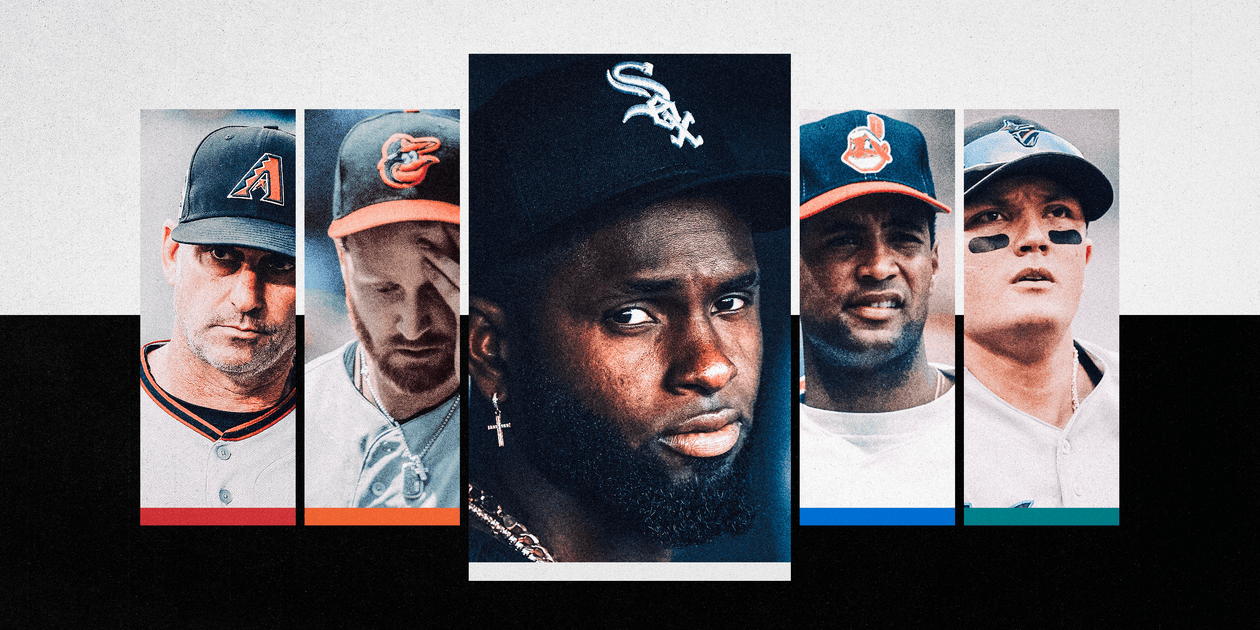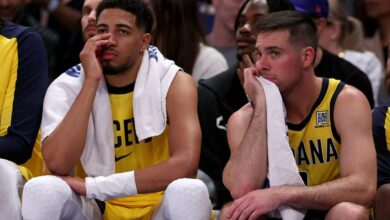How MLB players cope with – and grow from – playing on a terrible team: ‘You find ways’

CHICAGO – Just mentioning the year 1991 elicited a pained groan from Sandy Alomar Jr. as he leaned against a railing in the Cleveland Guardians dugout.
Three decades have passed. Alomar played for seven teams in 20 seasons, appeared in 49 playoff games, won an All-Star Game MVP award and provided a slew of unforgettable moments in a major league uniform. He has been coaching a consistent competitor in Cleveland for 15 years.
And yet he still can’t shake the memories of that miserable ’91 season. That’s what losing can do – not the kind of losing that dissatisfies players, coaches and fan bases, but the kind of losing that knocks the soul out of someone who can’t escape it.
“It hits you in the face every day,” said Cleveland pitcher Alex Cobb, a member of the 115-loss Baltimore Orioles of 2018. “Wake up, do it again. Wake up, do it again.”
Scanning the dugout of the historically inept Chicago White Sox during an early September series with a mostly empty guaranteed rate field caused some flashbacks for Cobb.
He signed with the Orioles in late March 2018 and played catch-up for much of the year. By the time Cobb felt like himself again, the Orioles were 40 games out of first place and he had a dozen more starts to make. He focused on tightening up his mechanics for the next season.
“You’re just trying to get through the day,” Cobb said. “You find ways.”
Of course, no one will feel sorry for a top-flight player who earns a seven-figure salary, has plenty of legroom on charter flights, gorges on endless portions of red meat at Brazilian steakhouses on days off during a road trip and throws a ball for a few hours every five days.
“I don’t remember anyone feeling sorry for us,” said Orioles outfielder Cedric Mullins, who blossomed in 2021 when Baltimore lost 110 games. “It actually felt like blood in the water at that moment.”
Still, it takes a mental toll on those who complete nine fruitless innings night after night. No one knows it better than the White Sox, who on Friday broke the 1962 New York Mets’ record of 120 losses. Chicago was eliminated from the playoffs in mid-August. They sit more than forty games behind fourth place in their division, a situation so bleak it would test anyone’s drive.

GO DEEPER
Where do the Chicago White Sox rank among the worst teams in any sport?
“It’s definitely a challenge to stay locked in and motivated,” said Ryan O’Hearn, a member of a pair of Royals teams that lost more than 100 games.
In 2021, Mullins became the first player since the franchise moved to Baltimore in 1954 to score 30 home runs and 30 stolen bases in a season. But he admits that “it just wasn’t that fun” because the team was terrible. His production has dropped over the past three seasons, but he said he has enjoyed the experience more.
“It’s funny,” he said, “when we go through stints like (the club’s recent funk), it feels like we’re losing. And I’m like, ‘Y’all have no idea.’”
-

Baltimore outfielder Cedric Mullins was a lone bright spot for the 2021 Orioles, who lost 110 games. (Rich Schultz/Getty Images)
When Torey Lovullo guided the Arizona Diamondbacks through a 52-110 season in 2021, his 25-minute drive home from Chase Field was “dark.” He sang along to Supertramp or Led Zeppelin to relax and distract himself from the difficult match that awaited his club the next day.
“I tried to go home and just be present at home,” Lovullo said, “and that became more and more difficult as the season went on.”
Several players said they would stay home longer before heading to the ballpark, preferring not to spend an extra nanosecond in the monotonous misery.
“It can feel like a project to get to the stadium itself,” said Cincinnati Reds reliever Buck Farmer.
Farmer led the 2019 Detroit Tigers in appearances, with 73. The Tigers were 29-44 when he pitched and 18-70 when he didn’t.
“We have lost a lot,” he said. “In my entire tenure there, we lost a lot.”
One hundred and fourteen games in 2019, to be precise. Enough to draw comparisons to the 2003 Tigers, who rallied during the final week of the season to avoid joining the ’62 Mets in the pantheon of futility.

GO DEEPER
How the White Sox went from first place in the AL Central to worst of all time in three short years
“September was very difficult,” said Matthew Boyd, who made a team-high 32 starts for the 2019 Tigers.
However, both ex-Tigers pitchers agreed that there isn’t much difference between 114 losses and, say, 98, which is how many games Detroit dropped the previous two years.
“It’s all hard,” Boyd said.
“Either way, it sucks,” Farmer said. “No matter how you put it, it’s hard not to have a winning season. It sucks to lose.”
Clubhouse culture “can dictate how much that sucks,” Farmer said. In 2019, for example, “it was like showing up for a 9-to-5 call, which sucks.” Do you sense a theme here, or at least notice a particular word that sums up the effects of constant losing on the psyche?
“It could have been a lot better,” said catcher Jake Rogers, another member of the 2019 Tigers. “It’s just like the (2024) White Sox. You get to a point where everyone says, “How many have we lost?” That part sucks sometimes, but we didn’t think that at the time. But you look back on it and you’re like, ‘Man, 114 is a lot.’
In 2022, the Reds started the season 3-22, but Farmer insists no one would know based on the energy in the clubhouse. This may depend on the composition of the schedule. When winning proves impractical, team goals often slip from players’ priority lists.
“I’ll never be okay with losing,” Los Angeles Dodgers infielder Miguel Rojas said.
Late in the Miami Marlins’ march to 105 losses in 2019, the players held a meeting after a series in Arizona. Rojas asked his teammates “to look at themselves in the mirror and look up (other) rosters (to determine) how many teams you could play for today,” a motivation method he said he learned when breaking into the major competitions.
“It’s hard to get knocked out a month before the season is over,” Rojas said. “It’s difficult because the fans feed off that too. … It’s really hard to ask people to come to the ballpark. So it’s very difficult to come to the ballpark every day. It is really energy efficient. You find your own motivation to play the game. But you have to be professional. You have to show up every day because you get paid.
“Everyone is at a certain place in their career,” Cobb said. “When you go to arbitration, you try to cover up as many numbers as possible or prevent bad numbers from happening. If you’re older, under contract, you’re probably just trying not to get hurt and trying to work on things for the next year.
And if you’re new to the big leagues?
“On a team like that, there’s a lot of guys that are super excited to be here,” Cobb said. ‘You can’t ruin that for anyone. You can’t take away other people’s joy when you’re in the locker room.”
As the 2018 trade deadline approached, the Orioles dealt Manny Machado, Zack Britton, Kevin Gausman, Darren O’Day, Jonathan Schoop and Brad Brach. In the second half, Cobb looked around the room wondering who everyone was. He said the influx of young players ultimately “helped the mood.”
That youthful exuberance can help dispel feelings of nihilism. As Cobb described, “You put the X over the days on the calendar, and you just try to get through it.”
“It’s hard to find those bright spots,” Mullins said. “And those bright spots won’t be looked at too often, just because (of) the team. You want to see the team perform. Individuals cannot do this alone.”
Outfielder Austin Hays, like Mullins, broke out for the Orioles in 2021.
“You really have to examine why you’re playing when you’re down 8-0 in the third inning,” said Hays, who credited the birth of his son with giving him perspective.
During a 102-loss season with the Oakland Athletics in 2022, catcher Stephen Vogt — now the Guardians’ manager — encouraged veteran players to be “an extension of the coaching staff,” pitcher Cole Irvin said. Vogt would engage the team’s young players in pitching tendencies or reading hitters’ swings.
The most reassuring memory Vogt gave?
“You are what the 12-year-old version of yourself wanted to be,” Irvin said.
That twelve-year-old self couldn’t wait to get on the field, regardless of the team’s results from the previous day, week or month.
“It’s very difficult,” Boyd said, “but it’s a balancing act. You must have consciousness. You’re going to step out of line, and when you do, you have to give yourself the grace to gently get back into it.
However, those trudges to the finish line can leave scars.
As Alomar shook his head and remembered that 105-loss Cleveland season in 1991, his former teammate, Carlos Baerga, drew closer. Alomar stopped him and mentioned the infamous year. Baerga screamed as if he was suffering from appendicitis and then remembered the most valuable advice he had received in his career. Batting instructor Jose Morales told him, “Don’t get used to losing, because when you get used to losing, you become lazy.”
Alomar and Baerga came together with the Padres, winning minor league championships in two of their final three years in the farm system. Then they were shipped to Cleveland, where the Indians lost so much that they became a baseball punch, playing for small gatherings in a cavernous dungeon on the shores of Lake Erie.
They never sank lower than they did in 1991. Cleveland went four decades without a playoff appearance after a trip to the World Series in 1954, but no version of the Indians lost more than that ’91 team.
Alomar partially tore his groin from his pubic bone, ending his season in late July with the club tied at 33-63. He still showed up at the stadium every day, like a wounded animal plodding to the slaughterhouse. All he had to see in the opposing dugout were a few experienced players, and he knew it.
“They’re probably going to screw us,” Alomar said.
— The Athletics Sam Blum, Chad Jennings, C. Trent Rosecrans and Cody Stavenhagen contributed to this reporting.
(Top image: Meech Robinson / The Athletics; Photo by Torey Lovullo: Steph Chambers/Getty Images; Alex Cobb: Rick Madonik/Toronto Star via Getty Images; Luis Robert Jr.: Thearon W. Henderson/Getty Images; Sandy Alomar Jr.: Focus on Sports / Getty Images; Miguel Rojas: Mitchell Layton/Getty Images)




